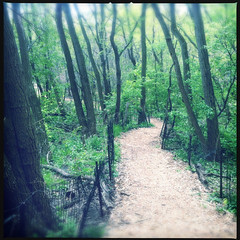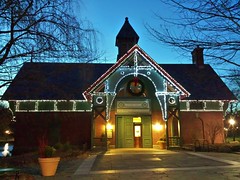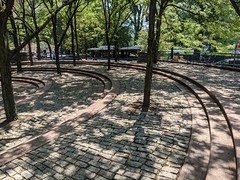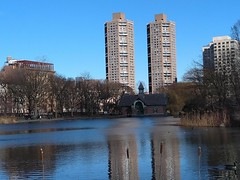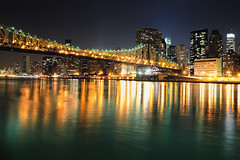South:
Corner (2828): This 12-story apartment building, built in 2002, has an H Mart Korean grocery on the ground floor. It was built on the site of the
Lion Palace Music Hall, built before 1864 as the Belvidere, said to be the largest dancing pavilion in the US. It was part of Lion Park, a spacious pleasure garden associated with the Lion Brewery on 108th Street. In 1910 it became the
Nemo Theatre, part of the Fox cinema chain. In 1964 it became the Daitch-Shopwell supermarket.
550: Congregation Ramath Orah, an Orthodox synagogue founded in 1941 by Jews from Luxembourg who
fled the Holocaust. The building went up in 1921 as the West Side Meeting House, a Unitarian temple whose name is still on the facade.
544: Harmony Hall, Columbia student dorm that used to be the Harmony Hotel. (An old ad on 114th Street described it as a place "where living is a pleasure.") The building dates to 1928, designed by Charles E. Birge for the
Explorers Club, which only met here until 1932. The hotel was apparently named for real estate developer
William Harmon, one of the Explorers Club's benefactors.
520: Twelve stories from 1911, designed by Schwartz & Gross in the Arts & Crafts style. Originally known as the Prince Humbert, whose namesake became
Umberto II, the last king of Italy.
514: Cathedral Tower apartments, a near-twin of 520, another 12-story Schwartz & Gross building from 1911. Originally known as the Marc Antony.
504-510: The Amsterdam-Cortlandt, also known as Casa de Dani. Built as two separate 12-story buildings in 1909-10, both designed by Schwartz & Gross, and later combined internally.
William Marston, Wonder Woman's kinky creator, lived at 504, which was the Amherst.
500 (corner): A 1908 Renaissance Revival building by Bernstein & Bernstein, also known as 1018 Amsterdam. The six-story apartment house features Marlow Bistro, Mediterranean, on the ground floor.
|  It was called the Muhhekunnetuk by the Mahicans, meaning the River That Flows Both Ways—a reference to its formal status as an estuary or fjord, a glacier-carved branch of the sea with salt water as high as Newburgh and tides all the way up to Troy. Originally known by the Dutch as the North River—as opposed to the South River, now called the Delaware—its current name honors Henry Hudson,
the English explorer who sailed up it in 1609. He's also the namesake of Hudson Bay, where mutinous crewmen left him to his presumed death.
It was called the Muhhekunnetuk by the Mahicans, meaning the River That Flows Both Ways—a reference to its formal status as an estuary or fjord, a glacier-carved branch of the sea with salt water as high as Newburgh and tides all the way up to Troy. Originally known by the Dutch as the North River—as opposed to the South River, now called the Delaware—its current name honors Henry Hudson,
the English explorer who sailed up it in 1609. He's also the namesake of Hudson Bay, where mutinous crewmen left him to his presumed death.









